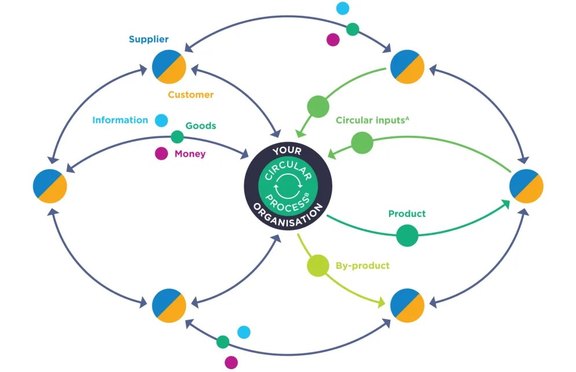“In the future, disruptions — from natural disasters, political unrest, and resource scarcity —
are only expected to increase, and it’s imperative that supply chains are prepared to meet that challenge."
Abe Eshkenazi, CSCP, CPA, CAE and Chief Executive Officer of the Association for Supply Chain Management (ASCM) introduces with this foreword the whitepaper Building a Circular Supply Chain by the Ellen MacArthur Foundation. The whitepaper focuses on the transition from traditional, linear supply chains to circular supply chains as a means to achieve resilient operations in the context of a circular economy.
Here are the major findings and key points from the whitepaper:
- Circular Economy and Supply Chains: The paper emphasizes the importance of reconfiguring supply chains to support a circular economy, where economic activity is decoupled from the consumption of finite resources. This shift is crucial for resilience and sustainability.
- Supply Chain's Role in Circular Economy: Supply chain professionals play a pivotal role in this transition. They manage the flow of materials, control a significant portion of a company's cost of goods sold, and have a strategic position in organizations, making them essential in implementing circular economy principles.
- From Linear to Circular: Traditional linear supply chains follow a 'take-make-waste' model, which is unsustainable. In contrast, circular supply chains aim to eliminate waste and pollution, circulate products and materials at their highest value, and regenerate nature.
- Challenges and Opportunities: The transition to circular supply chains presents various challenges, such as network design, technological requirements, and changes in processes and mindset. However, it also offers opportunities like material security, cost savings, reduced environmental impact, and compliance with emerging sustainability regulations.
- Circular Supply Chain Characteristics: These supply chains are characterized by distributed and interconnected networks of partners, multidirectional flows of information, goods, and money, and the utilization of circular inputs and processes.
- SCOR Model for Circular Economy: The SCOR model, a framework for supply chain management, is adapted for the circular economy, emphasizing the importance of planning, sourcing, transforming, delivering, and returning processes in a circular context.
- Focus Areas for Transition: The paper identifies nine focus areas for the transition to circular supply chains: People and Structure, Network Design, Supplier Engagement, Data and Quality, and Metrics and Performance Management, among others. Each area comes with specific challenges and recommendations for supply chain leaders.
- Case Studies and Examples: The whitepaper includes case studies and examples of companies that are successfully implementing circular supply chain practices, providing practical insights and lessons learned.
Overall, the whitepaper advocates for a radical shift in how supply chains are managed and operated, highlighting the necessity and benefits of embracing circular economy principles to build resilient, sustainable, and profitable supply chains.
How can you get started?
- Your next step towards embracing circularity could be attending our two-day workshop titled Supply Chain Practice Workshop: Transforming from Linear to Circular Business. This event is scheduled for June 11-12, 2024, in Munich.
- Alternatively, you can delve deeper into the power of the ASCM SCOR model, which is also referenced in this whitepaper. The upcoming ASCM SCOR DS Workshop is scheduled for March 11-13, 2024, in Hamburg.

